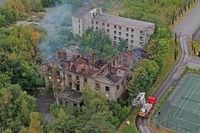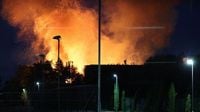On the evening of August 19, 2025, the historic Woolton Hall manor house in Liverpool was engulfed in flames, sending shockwaves through the local community and reigniting urgent questions about the fate of one of the city’s most storied buildings. Fire crews from Merseyside Fire and Rescue Service (MFRS) rushed to the Grade I-listed property just after 8pm, responding to reports of a major blaze at the three-storey stone-built structure that has stood for more than three centuries.
By 9:30pm, the seriousness of the situation was clear: eight fire engines and an aerial appliance were at the scene, and by 11:30pm, that number had risen to nine. The fire, which quickly consumed the roof and much of the interior, was described by MFRS as “fully involved,” with flames visible across a 40 by 30 meter area. Residents in the surrounding Woolton suburb were warned to keep doors and windows closed as crews battled the inferno through the night. The main body of the fire was finally extinguished just before 2am on August 20, but the damage was done—the roof had collapsed, and much of the manor’s historic fabric had been gutted.
As dawn broke, the full scale of the devastation became apparent. Woolton Hall, which had survived wars, changing fortunes, and decades of neglect, was now a charred shell. The incident immediately drew the attention of Merseyside Police, who launched a joint investigation with MFRS to determine the cause of the fire. Initial inquiries pointed to arson. According to police reports, a large group of youths had been seen gathering near the hall shortly before the fire broke out.
Detective Inspector Daniel McWhinnie of Merseyside Police addressed the community’s concerns, stating, “This appears to have been an extremely reckless act at a historic building that has stood at the site for hundreds of years. We know the community will be rightly shocked by what happened and we are determined to find all those responsible.” He appealed for witnesses, adding, “If you are a parent or guardian in the area and your child was out that night, we ask that you enquire about their movements and what they might know. If you were driving in the area of Speke Road on Tuesday evening and captured anything on dashcam that you think in hindsight may be useful to our enquiries, please get in touch.”
On August 21, police arrested a 14-year-old girl from Liverpool on suspicion of arson. She was taken into custody for questioning and has since been conditionally bailed. The investigation remains ongoing, with authorities urging anyone with information to come forward. The force has specifically called on parents whose children were out that night to ask about their whereabouts and knowledge of the incident.
The fire at Woolton Hall is not the first such incident at the site. In 2019, fire crews were called to tackle a suspected arson attack in the hall’s outbuildings, narrowly preventing the blaze from spreading to the main structure. That event prompted Historic England to add Woolton Hall to its Heritage at Risk Register in 2021 as a Category A site, meaning it was at “immediate risk of further rapid deterioration or loss of fabric.” Local campaigners have been calling for years to save the building, which has stood vacant and vulnerable to vandalism for nearly two decades.
Woolton Hall’s story is one of grandeur, adaptation, and, in recent years, decline. Built in 1704 by Richard Molyneux, 1st Viscount Molyneux, the manor was remodeled in 1772 by renowned architect Robert Adam at the behest of owner Nicholas Ashton. Over the centuries, it changed hands multiple times, serving as the residence of shipping magnate Frederick Richards Leyland, a hydropathic hotel until 1912, military headquarters and army hospital during the First World War, and a girls’ school run by the Convent of Notre Dame from the 1950s until 1970. The hall narrowly escaped demolition in the 1980s, thanks to a local campaign and the efforts of resident John Hibbert, who briefly restored it as a community venue. Yet, by the early 2000s, the building had fallen into disuse and disrepair.
Local authorities and heritage groups have long expressed concern over the hall’s condition. Its designation as a Grade I-listed building in 1982 recognized its exceptional architectural and historic significance, but this status offered little protection against the ravages of time, weather, and, as recent events have shown, human recklessness. Liverpool City Council has pledged to fully cooperate with the ongoing investigation, emphasizing the importance of preserving what remains of the site.
For many in Liverpool, the fire at Woolton Hall is a gut-wrenching loss. The building has been a silent witness to centuries of local history, its walls bearing the marks of changing eras and uses. The fact that it has now been the target of suspected arson twice in six years only deepens the sense of urgency among those who have campaigned for its rescue. As one local campaigner put it, “Woolton Hall isn’t just bricks and mortar—it’s part of our community’s soul.”
The legal ramifications for those involved in the fire could be severe. Under the Criminal Damage Act 1971, arson is defined as deliberately or recklessly setting fire to property, and penalties can range widely depending on the circumstances. Simple arson, where property is damaged without intent to endanger life, carries a maximum penalty of life imprisonment if tried in the Crown Court. In less serious cases, especially those involving juveniles, sentences may include fines, community orders, or detention in a young offender institution. Courts may also impose restraining or compensation orders for victims. The severity of the Woolton Hall blaze—its impact on a protected historic site and the risk posed to the community—means that the investigation and any resulting legal action will be closely watched.
As the community grapples with the aftermath, police and fire officials continue to piece together the events of that night. Detective Inspector McWhinnie’s words echo the mood in Woolton: “We are carrying out a number of lines of enquiry, including speaking to potential witnesses and assessing CCTV in the area, but I would ask for anyone who knows anything to contact us as soon as possible.”
For now, Woolton Hall stands as a stark reminder of both Liverpool’s rich heritage and its vulnerabilities. Whether the latest tragedy will finally galvanize action to secure its future remains to be seen, but one thing is certain: the story of Woolton Hall is far from over.


